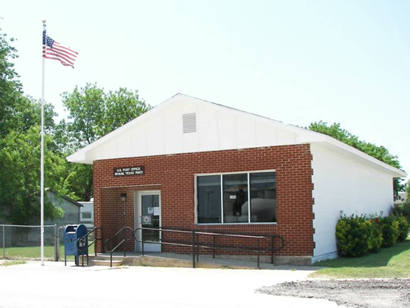Bynum Texas. (original) (raw)

The US post office in Bynum, TX 76631
Photo courtesy Barclay Gibson, April 2006
History in a Pecan Shell
The town which was settled on an Indian burial ground was named for a pioneer settler. In 1882 a post office named Hanover was established. The post office and a store both closed two years later. A second store opened in 1890 and storekeeper Henry M. Mucklevane applied for a post office under the name of Bynum. Within two years Bynum had a population of 150 and all essential businesses as well as two doctors and The Bynum String Band.
With the arrival of the Texas and Brazos Valley Railroad in 1904, the town shifted a half mile to be alongside the rails. The town took the unusual step of buying a farmer's land for the new location. When the lots went on sale the town had a population of 163. Three churches were moved from the former town site and in 1905 a brick two-story school was constructed.
In the mid 1920s, with the population around 350, Bynum experienced a business district fire but soon rebuilt the damaged stores. A second disaster in the form of a tornado destroyed downtown Bynum again in 1930. Between the cotton crop being infested by the boll weevil and the onset of the Great Depression, Bynum was hit hard. The railroad was jokingly referred to as the "Boll Weevil" route. Sold to the Burlington-Rock Island Railroad in 1930, the rails between Hillsboro and Hubbard were closed as a cost-cutting measure in 1935. Highway 171 which connects Hillsboro and Mexia was built about this same time period.
Bynum was still recovering after the end of WWII. When the Gilmer-Aikin Laws forced smaller schools to consolidate with larger districts, Bynum received a shot in the arm when schools in the nearby communities of Brandon, Davis, Grove Creek, Malone, Prairie Valley, and Watson had their schools merge with those in Bynum.
By the 1980s Bynum was left without a single business. Even the bank had moved to Hillsboro. The population was a mere 130 in the early 1970s which has since increased to the present 225.

Texas Escapes, in its purpose to preserve historic, endangered and vanishing Texas, asks that anyone wishing to share their local history, stories, landmarks and recent or vintage photos, please contact us.
